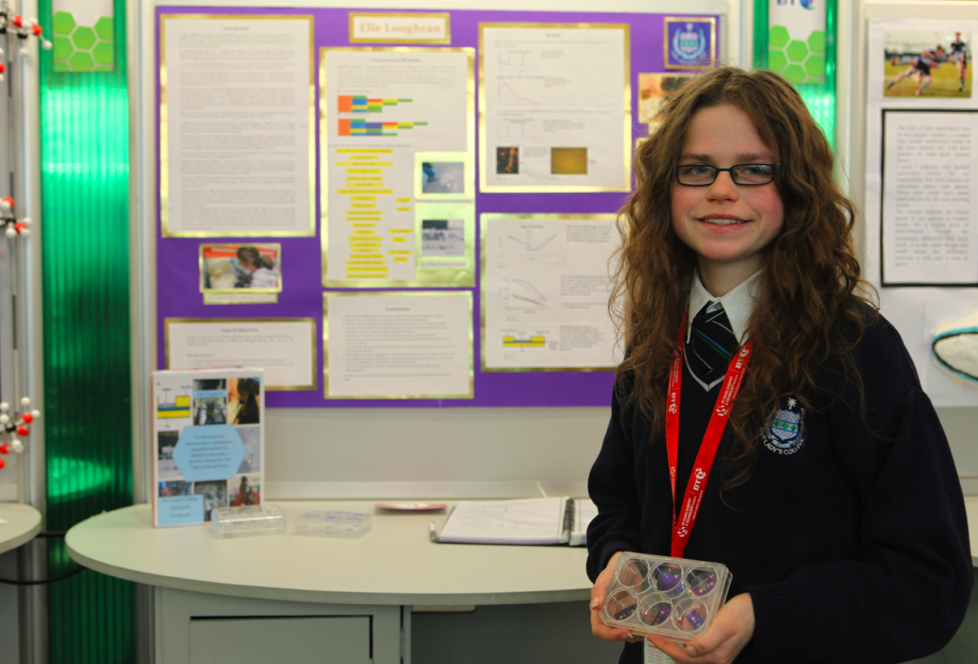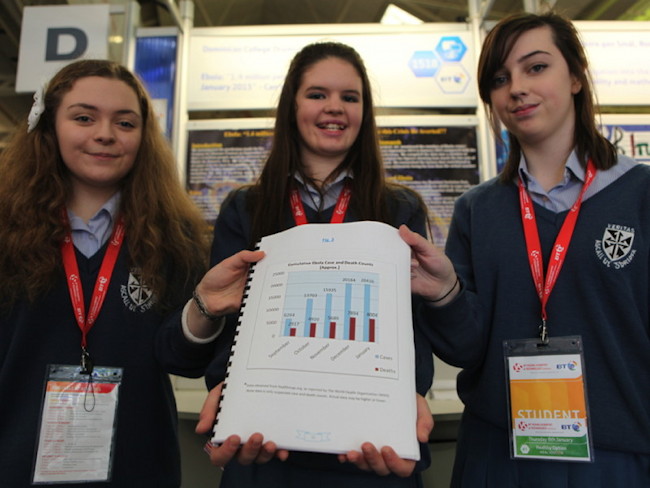Students enjoy the opening ceremony of the BT Young Scientist & Technology Exhibition 2015 at the RDS, Dublin, on 7 January. Photo Shane O'Neill/Fennell Photography
Diagnosing brain tumours, charting the rise of Ebola and mining seaweed for antimicrobial compounds: a new generation of female scientists is tackling health issues at the BT Young Scientist & Technology Exhibition.
Walking around the enormous hall in the RDS in Dublin, which is currently hosting around 1,185 students displaying 550 projects at the 51st annual ‘BTYSTE’, there is no shortage of female scientists who are applying their curiosity, knowledge and hard work to explore questions – and some of them are looking to tackle serious health issues.
BT Young Scientist & Technology Exhibition award winners were revealed the evening of 9 January in Dublin.
Among them are the young scientists featured in this article:
- Elle Loughran won a special award from Intellectual Ventures and won third prize for individual projects in the senior Chemical category
- Sadhbh O’Hanrahan, Ali Hill and Ciara Walsh won second prize in the Senior Group category in Biology
Attracting better sensors to diagnose brain tumours
One issue is how to make it easier to diagnose brain tumours. For her project, 16-year-old Elle Loughran, a 5th-year student in Our Lady’s College, Drogheda, used the nanomaterial graphene to help detect warning signals that a tumour could be present in the brain.
The key, she explains, is to measure levels of a protein called attractin in the cerebrospinal fluid, which can be sampled from a patient through a lumbar puncture procedure.
“If you have elevated levels of the attractin protein in your cerebrospinal fluid, it indicates a glioma which is a type of brain tumour,” explains Loughran. “So I wanted to make a sensor that can detect attractin.”
She contacted CRANN in Trinity College Dublin, and set to work under the guidance of Sinéad Winters in Prof Georg Duesberg’s lab. To build the system, Loughran linked graphene with an antibody that binds attractin, then she measured changes in the conductivity of the graphene when attractin bound.
“The sensor still needs a lot of development but the idea is that you take a lumbar puncture and you just drop the fluid onto one of these sensors and measure the changes,” she says.

Elle Loughran, a student at Our Lady’s College, Drogheda, used graphene to help detect warning signals that a tumour could be present in the brain for her project at the BT Young Scientist & Technology Exhibition in Dublin. Photo by Connor McKenna
Charting Ebola
Disease of a different kind was on the minds of three students from Dominican College in Drumcondra, Dublin, who charted the rise of the Ebola virus in West Africa since September.
Transition-year students Ellen Corr, Ciara Connolly and Emily Lawlor became interested in Ebola as a topical subject in the media. One widely publicised prediction, published in a report in September 2014, extrapolated that without additional interventions or changes in community behaviour, as many as 1.4m cases could accumulate in Liberia and Sierra Leone by January 2015.
For their project, the students charted data from the World Health Organization between September 2014 and January 2015, watching how the numbers panned out.
“We graphed the cumulative cases as they rose and compared them to the predicted numbers to see how far off they were, (and we looked at) what factors are affecting the actual numbers,” explains Connolly.
The numbers of reported cases currently stand at around 9,770 for Sierra Leone and around 8,100 for Liberia, and the students reckon that interventions such as health clinics, education programmes and changes in traditional practices (particularly around burial) have helped to avoid the predictions of 1.4m cases bearing out.

(Left to right) Ciara Connolly, Ellen Corr and Emily Lawlor, students at Dominican College in Dublin, have charted the rise of Ebola virus in West Africa for their project at the BT Young Scientist & Technology Exhibition in Dublin. Photo by Connor McKenna
Bug-fighting seaweed
With a crop of winners in recent years, Kinsale Community School has a stellar track record at the BT Young Scientist & Technology Exhibition, and for their project 5th-year students Ali Hill, Ciara Walsh and Sadhbh O’Hanrahan decided to look for new antimicrobial compounds in local seaweeds.
“The sea is an underexploited resource, and we live in a coastal area and we wanted to do something related to our locality,” says O’Hanrahan. “So we asked, what can we learn from the sea that might be helpful?”
The students collected numerous species of seaweed and became immersed in the project, using kitchen appliances, such as blenders, to prepare the algae, making extracts in the school lab and they went to microbiologist Prof Colin Hill’s lab at University College Cork to test for bug-fighting power.
The young researchers placed small discs of filter paper containing extracted compounds onto Petri dishes and grew bacteria on the dishes. If there was a clear section with no bacterial growth around the disc, it signalled that the extracted compound might be antimicrobial. But they weren’t leaving their results to chance and they made sure to crunch the numbers.
“It’s interesting because you might look at one dish and see there is a zone of inhibition where the bacteria aren’t growing you think ‘this is working’,” says Walsh. “But when you do the statistics it is not always significant.”
Their findings did suggest, though, that two of the extracts had antimicrobial activity, and their extraction methods mean they could be onto something new.
“We used a polar and a non-polar solvent to extract our compounds, and we found that non-polar (solvents) had not been used before to do this,” says Hill. “It ended up working, which means that some of the compounds that we extracted have never been tested before for antimicrobial activity.”

(Left to right) Ciara Walsh, Sadhbh O’Hanrahan and Ali Hill, students at Kinsale Community School in Kinsale, Co Cork, are presenting their project on new antimicrobial compounds in local seaweeds at the BT Young Scientist & Technology Exhibition in Dublin. Photo by Connor McKenna
Girls get involved
The 550 projects on show this week at the RDS were selected from 2,077 project ideas submitted in October by 4,616 students, 54pc of whom are female. The BTYSTE has a good track record of female participation, notes Colm O’Neill, CEO of BT Ireland.
“The first exhibition was in 1965 and a boy (John Monahan) won it, then in 1966 a girl (Máire Caitríona Ní Dhomhnaill) won it,” he says. “And in the years that I have been here more girls than boys have entered projects.”
One of the projects being showcased by girls this week that caught his attention was a project by Marieke Buckley and Niamh Twomey from Kinsale Community School, who investigated the public’s awareness of male suicide, educating youths regarding suicide and the public’s awareness of local support services. Another was a ‘sliotar tracker’ project that Aoife Mahony, Breanne Barrett and Freya Casey from Causeway Comprehensive School in Causeway, Co Kerry, undertook to develop a system that can keeps tabs on the ball using a smartphone app.
O’Neill reckons the BT Young Scientist & Technology Exhibition offers a good platform for students to get a taste of doing science outside the classroom.
“(Working in) science is not like learning it in the classroom,” he says. “It’s a much more collaborative, team-based interactive process.”
The BT Young Scientist & Technology Exhibition is open to the public today and tomorrow at the RDS, Dublin 4. Tickets: student €6/adult €12/family pass €25. For further information, visit the website or call 1800 924 362 in the Republic of Ireland or 048 800 917 1297 from Northern Ireland.
Women Invent Tomorrow is Silicon Republic’s campaign to champion the role of women in science, technology, engineering and maths. It has been running since March 2013, and is kindly supported by Accenture Ireland, Intel, the Irish Research Council, ESB, Twitter, CoderDojo and Science Foundation Ireland.
Inspire 2015 is Silicon Republic’s international event running 18-19 June in Dublin that connects sci-tech professionals passionate about the future of STEM with fresh perspectives on leadership, innovation and diversity.